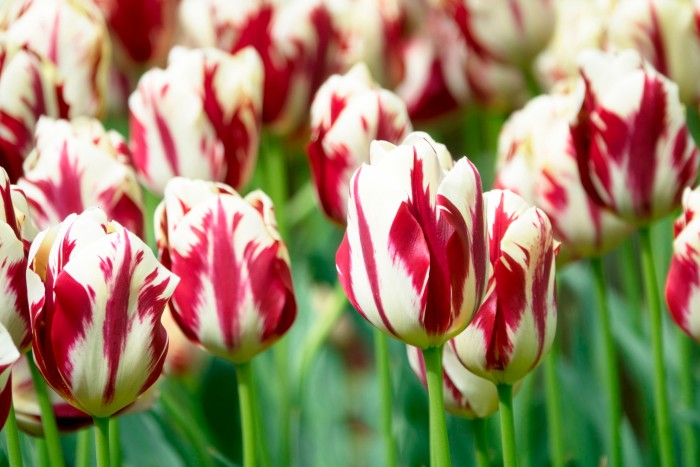Are tulips just too much trouble?

Unlock the Editor’s Digest for free
Roula Khalaf, Editor of the FT, selects her favourite stories in this weekly newsletter.
The ground is soft and easily planted with bulbs. The last spring flowering bulbs that should go in are tulips, readily plantable until late November. Tulips and I have had a rollercoaster ride in recent years, but I am checking in for another turn.
In the 2010s, when we started to have hotter temperatures in spring, I went off tulips. They flowered weeks early and dropped their petals after a few days of sunshine. For our Oxford college gardens I choose tulips predicted to flower in May when the undergraduates will be in residence to enjoy them. In accelerated spring times they flower in early April when the college is shut for Easter. For a few days I enjoy them, feeling spoilt and guilty that their target audience cannot.
Are they worth the cost and trouble, I began to wonder three years ago? Still wondering, I planted midseason Triumph tulips for this year’s spring as I needed a display on April 14, the date of the ceremonial inauguration of a newly built college quadrangle and its series of borders and flowerbeds. Mid-season Triumphs are billed as flowering in late April to May but, in a warmer season, I thought mid-April would be nearer the mark. As late as December 6 we planted our chosen varieties. We did not combine them first into a multicoloured mixture. We spaced them out in segregated groups of 20. The rain poured down our necks as we trowelled each one in, leaving four inches of soil above its tip and scattering a pinch of bone meal, a good trick, under its base. It seemed unlikely they would survive the wet and justify their name.
After a continuously mild and damp winter, they began to flower on March 6. A display for the inauguration seemed a lost cause, but the days and nights remained cold and to my amazement the tulips held their flowers for six weeks as if in an outdoor fridge. The mainstays were Flaming Agrass, a lovely blend of white and mid-yellow; blood red Hollandia, a great choice; and the excellent Grand Perfection whose cream and yellow flowers are feathered with dark red, like tulips in an old Dutch painting. I recommend them all, whatever the weather throws at them.

At home, I planted premixed assortments of Triumph tulips instead. I had high hopes, but they were planted within sight of wildlife in open country. Two setbacks destroyed them. First, the leaves on many of them began to turn brown and wrinkle: they were victims of the fungal condition called tulip fire. A frequent cause of it is excessive wet, just what last winter gave by the bucketful. There is no ready spray to kill it off. Worse, it persists in the soil for at least three years.
A few of my tulips avoided it and set promising buds. They advanced no further because in one night of murder a visiting muntjac bit off all the buds, eating some, scattering others uselessly on the ground. So much for wildlife in the garden, that indiscriminate mantra. It bites off more than it can chew.
This year I will try a different tactic, one that will bring my plantings closer to many of yours. I will plant the tulips in big clay pots and space the pots in the gaps in flowerbeds where dahlias have been sulking in the recent wet weather. Out come the dahlias to be stored away from frost until late May. In their place will go clay pots wide enough to take about 10 tulips each. I will buy cheap pots from supermarkets and keep the tulips out of reach of animals at ground level. Between the pots I will mix blue forget-me-nots and double pink and white bellis, known as bachelor’s buttons. In pots, the tulips will be in fresh soil, free of fungal tulip fire. Except for the menace of wildlife, the pots could be black plastic, sunk into the surrounding soil but shielded from its diseases. If so, they need to be watered in a dry spring.
In urban courtyards or on balconies you may be potting tulips too: in a range that can seem bewildering, which are good choices? Tulips span months from March to May, so make use of the full season. I begin with Water Lily tulips, which usually in flower in March. Their flower stems are less than a foot tall so they are excellent choices for window boxes, yellow and red Giuseppe Verdi and cream and red Johann Strauss being my favourites. In window boxes lily-flowered tulips are no good as they are too tall and flop badly. The fosteriana group is much better — lovely white Purissima and vivid scarlet Madame Lefevre being the best in early April.

For mid-May, Tulip Queen of the Night is a top-seller: a dark maroon that is indeed almost black. I mix it in pots with a few white ones, especially Alabaster, which flowers at the same time: six or seven black to three white. Another chic option is a green-flowered variety from the viridiflora group, which flowers in late April; Green Spirit is a cool customer, a cream-white with green stripes on its petals, as is the similar Spring Green. In pots they are eye-catching, but after a long wet winter I am even more cheered by Yellow Spring Green, a bright yellow with green stripes, a tulip that opens prettily and holds itself well.
Tulips offer colours unlike any other flower, so it is fun to choose them. I particularly like those that are streaked or striped, Olympic Flame being my top choice, a Darwin hybrid whose primrose yellow flowers are streaked with red. In pots, the ruffled flowers of parrot tulips are fun too, especially the robust Estella Rynveld, a May-flowering tulip whose white flowers are twirled with red and streaks of green, and Flaming Parrot, whose mid-yellow flowers are feathered in bright red. In flowerbeds, parrot tulips in a block look too exotic, but in pots they are very striking, apt for their artificial setting.

Parks and public gardens accustom our eyes to tulips massed by the hundred in only one colour. In a broad open space they are impressive, but in a garden I find small groups, dotted in tens, are more effective and obviously much cheaper. In the beautifully planned gardens at Coton Manor in Northamptonshire, double-flowered tulips are planted in small groups where the bare earth is visible in the broad borders of summer flowering plants. They look like early peonies and blend in beautifully, pink Finola with a dash of white being the garden’s favourite. I am trying white-and-red streaked Carnaval de Nice for this purpose, badgers permitting. It is an excellent use for double tulips, which simulate peonies and otherwise look too fussy.
Good choices proliferate, but these are a start. Water lily tulips will often flower well for a year or two, but the others I have named are one-year wonders. The bulbs split in British gardens and seldom build up to a size that flowers again. Tulips are the very opposite of sustainable. They are unmissable, unlike sustainable, tedious ground elder. Beauty is still beauty, even if it lasts for no more than a fortnight.
Find out about our latest stories first — follow @ft_houseandhome on Instagram
#tulips #trouble




